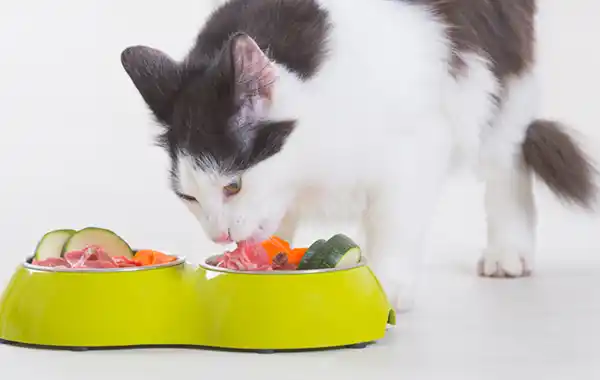Thinking about feeding your cat a raw diet? We take a look at whether a raw food diet is better for cats.
Feeding cats a raw diet means feeding them uncooked animal muscle meat, organ meat, and bones. This type of food is sometimes called the BARF diet, which stands for "bones and raw food" or biologically-appropriate raw food.
Cats do not actually need vegetables and carbohydrates in their diets. In fact, they can only tolerate carbohydrates in small amounts. Instead, cats thrive on high-protein, high-moisture diets rich in substances only found in meat.
Most nutritionists will recommend that if you are using a home-cooked recipe, it is sensible to vary the ingredients using reasonably equivalent substitutions to balance out any marginal nutritional deficiencies. This needs quite a lot of nutritional knowledge, and if you are going to take this approach you should do as much reading as you can on the subject.
There is a lot of controversy around raw food diets for cats. Those who support raw food diets say there are many health benefits, including shiner coats, cleaner teeth, obesity is prevented, and their overall health is better. While these claims are usually true, the opposition has valid concerns about the safety of raw food diets.
Is a raw food diet safe for my cat?
Cats can often digest raw foods better than humans because they have shorter, more acidic digestive tracts. Many pathogens, such as like Salmonella and E. coli, will pass through a cat without causing any issues, but not all cats can tolerate raw food.
Perhaps the greatest risk of feeding and handling raw meat comes down to cross-contamination. If you feed your cat a raw food diet you could be exposing you, and other people in your home, to dangerous pathogens. These pathogens can remain on preparation surfaces, food dishes, in cat fecal matter, and even on your cat, especially around their face.
If there are raw eggs in the recipe, you will have have to consider whether you are happy with the salmonella risk these present, or the risk from meat that is not fully cooked enough to destroy all bacteria. It is a small risk, but you should make an informed decision. Be sure to prepare and store the food properly to minimise the risks of contamination, try to ensure that you get the amount of bone right (i.e. not too much), and that there are no large chunks of bone.
Ingredients often used in a raw food diet:
- Raw meat from muscles and organs (good sources include poultry, rabbit, and, fish)
- Ground raw bones
- Eggs
- Supplements (required)
You will likely need the following equipment to prepare the raw diet:
- Large cutting board
- Meat grinder (A butcher's grinder can cost about £1,000 so asking your local butcher to do the grinding of any bones may be your best bet)
- Stainless steel or glass mixing bowls
- Disposable gloves
- Storage containers suitable for the freezer
- Freezer and refrigerator space
Preparing a raw diet at home can be time consuming, so many owners prefer to make enough to last several weeks and keep it frozen. Always remember to carefully monitor your cat's health and weight.
Why do cats need to eat meat?
Felines are obligate carnivores. In short, this means they must eat meat to survive.
Cats have adapted to a hunting life that is based almost entirely on a totally animal diet.The way it actually feeds and digests is geared towards eating flesh. In the thousands of years since first being domesticated, cats have not changed in either their nutritional or behavioural requirements and animal flesh remains their main source of nourishment.
All the senses of a cat are adapted to respond to the make up and smell of meat. As they have to eat meat, cats are defined as obligate carnivores, unlike dogs, so need more protein than other mammals.
If the cat does not get the required amino acids from protein, then problems can occur. If the amino acid arginine is missing, for example, this can lead to clinical signs of lethargy and hypersalivation. This is needed by cats to synthesise urea, a waste product resulting from the breakdown of protein.
Another essential nutrient for your cat is the amino acid, taurine, which the cat cannot synthesise sufficiently by itself to meet its needs. The diet of a cat must therefore contain taurine in sufficient quantities. If there is a shortage then there is a high risk of serious and untreatable damage to major organs such as the eye and the heart.
Taurine is found almost entirely in meat and supports the concept of the cat as an obligate carnivore. Good diets, that include meat, therefore, are essential for the health of your cat to ensure normal growth and development.
Can I give my cat raw vegetables?
Although cats are obligate carnivores, when they're hunting and eat their prey, they eat the vegetable matter in the prey’s gut. Cats are built to tolerate a certain amount of roughage in their diets.
If your cat is overweight, adding some veggies to his diet can help keep his weight down. Feeding your cat vegetables can also boost his immune system and can lessen the effects of ageing.
Vegetables that can be good to offer your cat are:
- Chopped carrots
- Peas
- Frozen sweetcorn
- Broccoli florets
- Green beans
- Courgette
- Lettuce
- Spinach
Do not offer the following, as they are either toxic to cats, or difficult for them to digest:
- Garlic
- Onions
- Tomatoes
- Avocados
- Mushrooms








